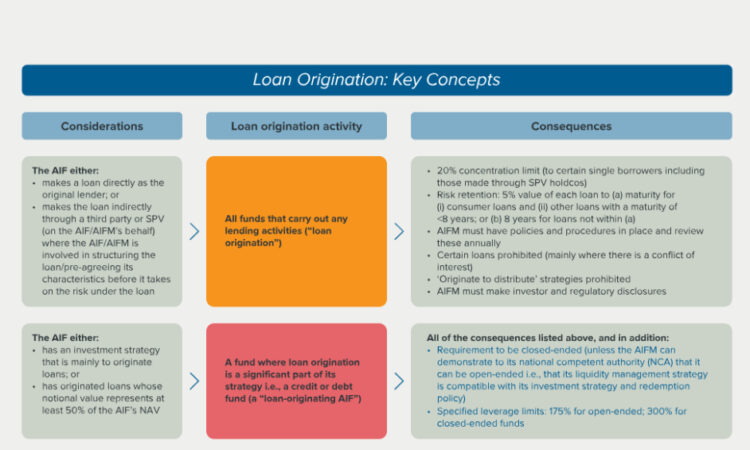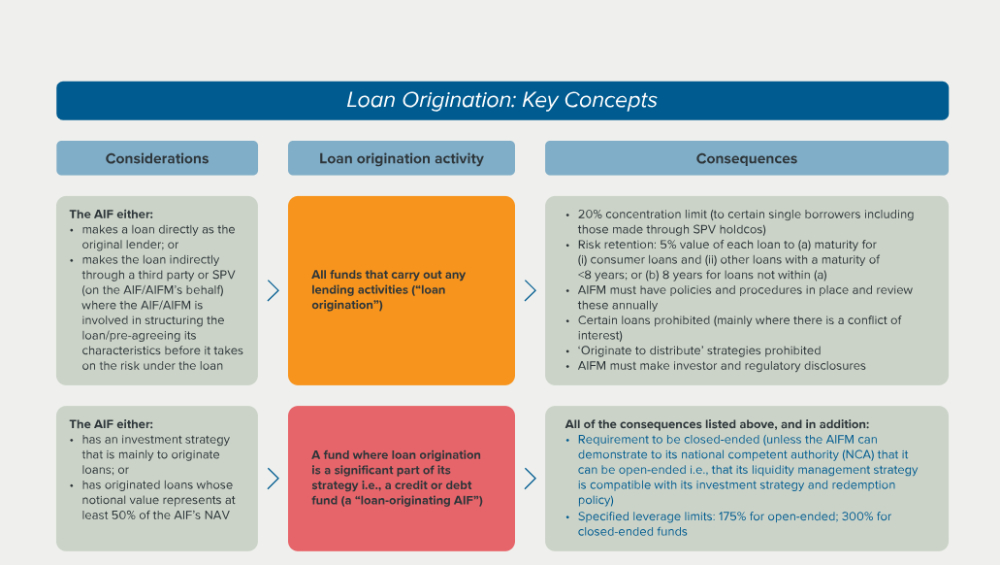
Introduction
The revised Alternative Investment Fund Managers Directive (AIFMD2) introduces new requirements for funds
managed by EU-based alternative investment fund managers (AIFMs)
that originate loans.
Most of the requirements apply to AIFMs that manage any fund
that originates loans, even on an occasional basis. Additional and
more stringent requirements apply to AIFMs who manage funds that
originate loans (“loan-originating AIFs”) as their
principal activity or investment strategy, i.e., a credit or debt
fund.
The table below identifies the differences between the two types
of funds. AIFMs will need to assess a fund’s categorisation and
whether the fund is closed or open-ended (which may not be obvious
in some cases, for instance semi-open-ended funds) on a
case-by-case basis.
The new requirements are designed to ensure stability and
integrity of the financial system and to introduce proportionate
safeguards.

Timing
Member states have to implement AIFMD2 by 16 April 2026, and the
Annex IV reporting template will take effect a year later, on 16
April 2027. Transitional provisions apply in some cases.
Impact of a Loan Origination Framework
The AIFMD2 changes will allow an AIFM to act for a fund
established in one member state to lend to borrowers in another
member state. The AIF is the originating entity, while the AIFM
acts on its behalf in arranging the loans for which the AIF becomes
the lender.
Although the AIFMD2 loan origination provisions are described as
a harmonising measure, they do not, in our view, create a lending
passport for AIFs; the AIFMD passporting rights apply to AIFMs and
not to the AIFs, which are the usual lenders. Moreover, member
states are free to introduce requirements that are more
restrictive, which include prohibiting AIFs from granting loans to
and servicing credit for individual consumers. Therefore, national
frameworks for product lending may continue to apply. Notably, a
member state will still be free to impose loan origination
requirements on non-EU AIFMs and AIFs marketed in that member
state.
These provisions apply whether or not the AIF is marketed to
professional and retail investors or only to professional
investors. For an EU AIF that is a European Long-Term Investment
Fund (ELTIF), European Venture Capital Fund (EuVECA), or European
Social Entrepreneurship Fund (EuSEF), the other applicable
regulatory restrictions and conditions will apply in addition to
those under AIFMD2.
Requirements and Restrictions
The table below sets out the key requirements: for any AIF that
carries on lending activities, only the requirements shaded green
apply; for those AIFMs of AIFs that are ‘loan-originating’
AIFs, the rules shaded yellow apply in addition to those shaded
green.
| Regulatory requirement | Obligations |
| Restrictions on open-ended funds |
A loan-originating AIF can be open-ended only if the AIFM can
Open-ended loan-originating AIFs will also be subject to the new
|
| Specified leverage limits |
Limits are 175% for open-ended funds and 300% for closed-ended
There are rectification provisions should caps be breached
There is a carve-out for shareholder loans (see below).
|
| Policies and procedures |
AIFMs must have effective and proportionate policies,
There is a carve-out for shareholder loans (see below).
We would expect many EU managers to already have procedures in
This is designed to mitigate risks to financial stability and
|
| Concentration limit |
This is a 20% limit on loans to a single borrower if that
The limit includes loans made through a special purpose vehicle
The limit applies after a ramp-up period of up to 24 months from
This diversification requirement is designed to contain the risk
|
| Risk retention |
An AIF has to retain at least 5% of the notional value of loans
For originated loans whose maturity is up to eight years (and
Various carve-outs apply (but there is no exemption for
This is to avert moral hazard and maintain the general credit
|
| No originate-to-distribute strategy |
Member states shall prohibit AIFs that follow an
As for risk retention, this is designed with the same moral
|
| Prohibited loans |
An AIF cannot lend to its AIFM or its staff, any AIFM delegates,
This is to limit conflicts of interest. The position of AIFM
|
| Proceeds of loans |
The proceeds of loans (minus any administrative fees) must be
|
| Disclosures and reporting |
Pre-contractual investor disclosures: the costs and expenses of
Periodic investor disclosures: portfolio composition of
Regulatory reporting: total amount of leverage used by the
|
Loan Origination: Threshold Issues
The table below identifies structuring considerations that may
affect the impact of the new requirements.
| Shareholder loan carve-outs: where loans can
be so structured at the underlying level (effectively with the loan stapled to the equity), there are two helpful carve outs. |
Definition of ‘loan’: where an AIF is
not involved in the origination of loans, it should not be subject to the loan origination requirements (and, where relevant, including as a loan-originating AIF). |
|
Shareholder loans are exempt from two requirements:
The other requirements set out in the table above will still
Shareholder loans are granted by an AIF to an undertaking in
|
There is no definition of “loan,” and the likely
|
Level 2 Measures to Follow
ESMA is to determine the requirements with which a
loan-originating AIF must comply in order to maintain an open-ended
structure (regarding a sound liquidity management system, the
availability of liquid assets and stress testing, and an
appropriate redemption policy having regard to the AIF’s
liquidity profile). This is to be done by 16 April 2025. Following
the recently-published consultations on AIFMD2 liquidity management
provisions, we expect these level 2 measures to be consulted on
shortly.
Transitional Provisions and Opt-in
The transitional provisions are detailed, and some apply on a
limited basis, as set out in the table below. They will need to be
considered on a case-by-case basis and depending on the activity of
the relevant fund.
| 5-year transitional period (until April
2029) for AIFMs managing AIFs that originate loans before 16 April 2024 |
||
|
For AIFMs managing AIFs that originate loans before 16 April
|
The deemed compliance applies indefinitely for pre-existing AIFs
|
From 16 April 2029, these AIFMs have to comply only with the 20%
|
| There are provisions to allow ongoing management of
loans originated by preexisting AIFs that exceed the 20% limit to any single borrower or the leverage limits for open- and closed-ended AIFs (provided that the AIFM does not increase those values or limits during the transitional period, i.e., up to 16 April 2029). |
||
| AIFMs can choose to be subject to the new
requirements (20% single-borrower limit, leverage limits, and the requirement to be closed-ended for loan-originating AIFs) before 16 April 2029, by notifying their NCA. |
||
Case Studies
We have looked at four case studies in terms of the impact the
new rules are likely to have.
Case Study 1
| Private equity fund granting loans that
launched after 16 April 2024: an AIF that grants traditional loans to its portfolio companies or SPVs (itself or via a third party of SPV) where the notional value of originated loans is less than 50% of the AIF’s NAV |
|
|
AIFMD2 analysis
|
This AIF will be subject to the requirements shaded green in the
It is not a loan-originating AIF and is therefore not subject to
No grandfathering applies.
|
|
Main Impact
|
20% concentration limit: possible issue for an
5% risk retention (but consider if any
Policies and procedures in place and reviewed annually (note
Prohibited loans (mainly conflict situations)
Prohibition on “originate to distribute”
Proceeds of loans
Investor and regulatory disclosures
|
Case Study 2
| An open-ended debt fund that grants loans
as its principal activity that launched before 16 April 2024, and is still raising capital |
|
|
AIFMD2 analysis
|
This AIF will be subject to the requirements shaded yellow and
Some of the grandfathering rules apply.
|
|
Main Impact
|
From 16 April 2026 to 15 April 2029:
|
Case Study 3
| An open-ended debt fund that grants loans
as its principal activity that launched before 16 April 2024, and is no longer raising capital |
|
|
AIFMD2 analysis
|
As for Case Study 2, this AIF will be subject to the green- and
However, as it is no longer raising capital, all of the
|
|
Main Impact
|
No compliance with new requirements (deemed
|
Case Study 4
| A closed-end debt fund that grants
shareholder loans only (which launched before 16 April 2024, and is still raising capital) |
|
|
AIFMD2 analysis
|
This AIF will be subject to the requirements shaded yellow and
But because it grants only shareholder loans, it will benefit
|
|
Main Impact
|
From April 2026: Investor and regulatory
From 16 April 2029: 20% concentration limit
|
Please do not hesitate to speak to one of the authors of this
guide or your usual Goodwin contact if you have any questions or
want to discuss how AIFMD2 loan origination may impact your fund
structures and investments.
The content of this article is intended to provide a general
guide to the subject matter. Specialist advice should be sought
about your specific circumstances.






